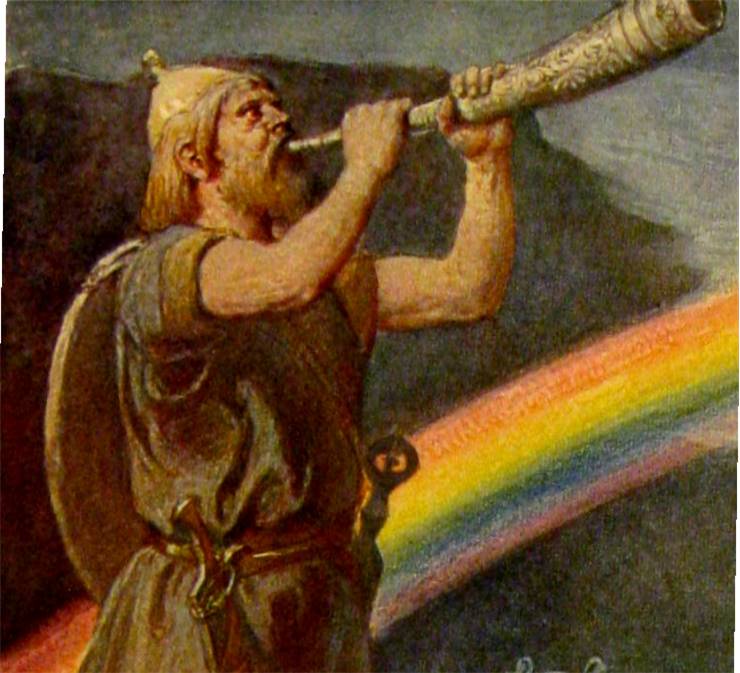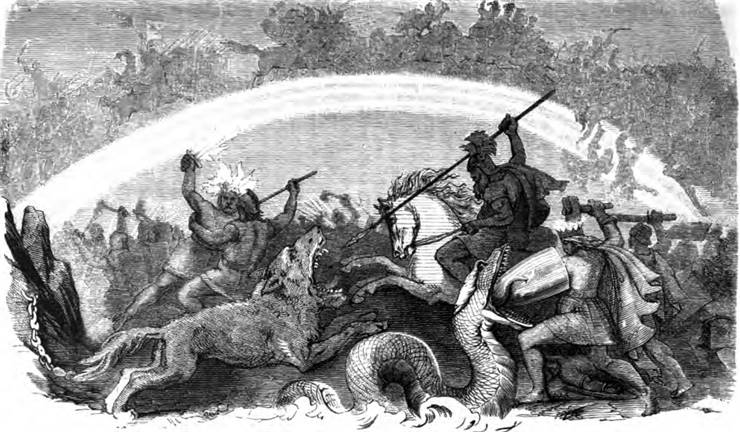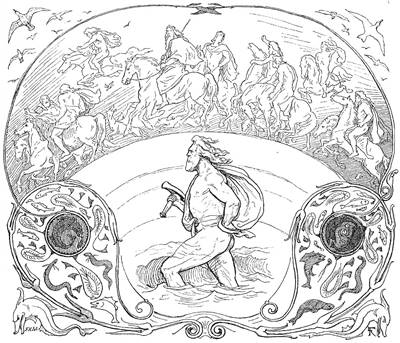Bifröst - Mythological Rainbow Bridge
Bifröst is the mythological rainbow bridge that connects the world of men on Earth (Midgard) with the realm of the Aesir Nordic gods that live in Asgard. In the collected stories about Nordic mythology, the bridge is described as the main way the Earth is connected with Asgard, and is used for transport of not only gods but also souls of men who have been proved worthy as warriors during their life to accompany Odin and other Nordic gods in the final “end times” battle during mythical event of Ragnarok.
In the records of the literary history, more precisely in the compilations of the 13th-century poems and earlier records Poetic Edda and Prose Edda, the bridge was described as a fleeting and unstable rainbow that touches the Earth from heavens, guarded at Asgard side on the guarded by the ever-vigilant god Heimdall. This “fleeting” and “trembling” description of the Bifrost is consistent in all the recorded poems and stories about Nordic mythology, giving meaning to every sighting of rainbows and signifying that behind every rainbow lies the path to the otherworldly Asgard. However, it is not the only rainbow that is closely connected with Bifrost. Many believe that the shape of Milky Way on the dark and clear sky was also a symbol of the Bifrost bridge. Nordic tales describe that Odin created a rainbow bridge using the elements of fire, air, and water.
Bifrost bridge is very closely connected to the myth of the apocalyptic event of Ragnarok, which describes series of future events, battles, destruction of the world, and the preordained death of almost all the major Nordic gods. The start of Ragnarok will be marked with two specific events – the disappearance of the sun and moon, and the sounding of the horn alarm by Heimdall who guards the rainbow bridge. This prompts Odin and almost all of the other Aesir and Vanir gods, Valkyries, and spirits of brave men who lived at Asgard to ride the Bifrost bridge back to the Earth where the final battle will be fought. In the battle all the gods will die, giants will storm across the Bifrost’s rainbow bridge, raise and destroy Asgard and the bridge itself. Earth, after being burned and submerged will eventually arise from the sea, being reborn anew.
In the modern history, the Nordic mythology and tales of Bifrost were preserved and popularized in several ways. Old songs, tales, writings and earlier traditional sources in Poetic Edda and Prose Edda from the 13th century, and Der Ring des Nibelungen (The Ring of the Nibelung), the series of operas and epic music dramas composed by German composer Richard Wagner which loosely covered major events of Nordic mythology.
Name Origin
The meaning behind the name Bifröst is a hotly contested item that has been closely examined by several historians over past several centuries. The core uncertainty comes from the several possible names that this bridge is known under, and the incomplete information that was collected in the earlier historical works such as Poetic Edda and Prose Edda. The original form of the name most likely is “Bilröst,” which can be loosely translated as “the fleetingly glimpsed rainbow.” The modern and more adopted version of the name Bifröst translates into something similar - “the shaking or trembling rainbow.”
Modern scholars also offer other translations. British academic in Old English, Norse and Celtic literature Andy Orchard claims that best translation of Bifröst is just “shimmering path,” but that the presence of the element “bil” (“a moment”) also paints the bridge with the “fleeting nature” of the rainbow. The old Norse word “bifa” (“to shimmer” or “to shake”) is also closely associated with the etymology of the word Bifröst. Additionally, Austrian Germanist Rudolf Simek suggest that Bifröst is most accurately translated as "the swaying road to heaven”.
Heimdallr
Heimdallr (also known as Heimdall, Heimdal, Heimdali, Rig, Hallinskiði, Gullintanni, and Vindlér or Vindhlér) is the Nordic god who is tasked with the protection of Bifröst bridge against the arrival of Giants who are foretold to destroy Asgard and Earth during the apocalyptic events of Ragnarok. He plays a vital role in Ragnarok and therefore has been bestowed with great importance in many Nordic myths that have been recorded in literary works of Poetic Edda and Prose Edda.
Modern scholars don’t have a clear picture of Heimdall because much of his surviving descriptions and attestations are incomplete, conflicting and collected from different ages. Historical information of Heimdall is today found in expansive work recorded in Poetic Edda and Prose Edda, the poetry of skalds (poets who worked at the Scandinavian and Icelandic medieval courts).
According to all the collective records, Heimdall is one of the most important gods in the Norse pantheon. Blessed with the power of foreknowledge, extraordinary sight and hearing, he was tasked to protect the Bifröst from his fortress of Himinbjörg that was located at the place where the shimmering rainbow bridge connected with the lands of Asgard. According to the prophecies known by the Aesir gods, Heimdall would be the first of the gods who will saw the signs of the upcoming Ragnarok, and was preordained to die in battle while killing Loki.
His appearance was of majestic beauty and light. He was armed with a flashing sword, horn Gjallarhorn (which he used to warn the Asgard gods of the upcoming danger that he could spot from far away), golden-maned horse Gulltoppr, and white armor that shone with bright light. According to some tales, he was a son of Odin and had Nine Mothers who are in the Norse myths depicted as sisters and personification of sea waves. They nursed him as a baby by enhancing him with the power of the Earth, the moisture of the sea and the heat of the Sun. This enabled him to gain the power of foreknowledge, keen hearing and eyesight. To be a better guardian of Asgard, he even requires less sleep than a bird. Some stories paint him to be a personification or closely connected with the world tree Yggdrasil.
The name Heimdallr cannot be fully traced to its true origin, but the historians agree that its name most likely can be translated to “the one who illuminates the world.” In surviving poems and stories, he is also notably called with three different names – Hallinskiði (no translation), Gullintanni (“the one with the golden teeth”) and Vindlér or Vindhlér (“the one protecting against the wind” or “the one protecting against the wind-sea”). Stories about him under these names have provided modern historians with valuable knowledge about his looks and exploits.
In Poetic Edda, Heimdall is referenced in six poems (Völuspá, Grímnismál, Lokasenna, Þrymskviða, Rígsþula, and Hrafnagaldr Óðins), while in Prose Edda, he is mentioned in three books (Gylfaginning, Skáldskaparmál, and Háttatal). He was also described in 13th-century Heimskringla Old Norse saga from Iceland and in the 10th-century Saltfleetby spindle whorl inscription that was recently found in England.
Bifröst in Literary History
The written information about the Bifrost bridge is not extensive and can be traced to just the two poems in the Poetic Edda and two books in the Prose Edda, with some additional context being derived from surviving medieval Scandinavian songs and tales.
The two appearances of Bifrost in Poetic Eda are:
In the poem of Grímnismál, Odin (disguised as Grímnir) talks with human warrior Agnarr, sharing with him the secrets of the universe, including the fact that the Bifrost is “the best bridge,” and that it has the power to burn everything, even the flame.
In the poem Fáfnismál, the dying dragon (wyrm) Fafnir shares with the human hero Sigurd the tale of the events of Ragnarok. He described the moment when the gods will descend from the Asgard to Midgard, riding their horses over the rainbow bridge Bifrost who will at that moment break apart and be destroyed forever, leaving the gods on Midgard where they will be forced to pass great rivers with their horses.
And here is how the Bifrost has been described in Prose Eda:
In the 13th chapter of the book Gylfaginning, King Gylfi in disguise asks High, one of the three throned figures, about what exists between heaven and earth. High responds that there exists a bridge that was built by gods, and that he must have already seen it because it looks like a rainbow that consists of three colors and has great strength. However, he also added that the bridge would break when giants from the realm of Muspelheim charge over it during the event of Ragnarok, dropping the advancing army of gods to swim over great rivers.
Later in the book, another throned figure Just-As-High spoke that the Bifrost is also known under the name of Asbrú, and it carries gods and their horses to the holy well of Urðarbrunnr where gods hold their court. He also confirmed that red color in the Rainbow bridge represents fire, which prevents anyone but gods to travel to it from Midgard to Asgard. Curiously, he also adds that Thor does not ride over the bridge, but has to go on foot.
In chapter 17, High confirms that location of the Heimdall’s castle Himinbjörg is just at the point where Bifrost reaches the land of Asgard, and that is from there where Heimdall protects the gods from mountain Jotnar giants.
In the book Skáldskaparmál, Bifrost bridge is mentioned only once and was described as “the power’s way.”
Theories and Explanations
Since many things about Bifrost bridge are unknown, can be interpreted in many ways due to translation inaccuracies, or have conflicting elements, many theories have arisen about various aspects of the rainbow bridge.
John Lindow, professor emeritus specializing in Scandinavian medieval studies and folklore, has proposed a connection between Bifrost and bridge Gjallarbrú. The former connects the land of the living with the realm of the gods, while the latter connects the land of the living with the underworld (or the world of the dead).
There is a belief that Bifrost should not be represented as a rainbow, but as the Milky May in the night sky.
There are several theories about the information presented in Prose Eda’s Gylfaginning book where Thor was described as needing to walk in the last days of Ragnarok. Other interpretations simply point that Thor’s walking signifies the end of the rainbow after the rain.
Bifröst in Marvel Cinematic Universe
In the Marvel Cinematic Universe, the rainbow bridge Bifrost is an interstellar portal powered by advanced technology that connects the realm of Asgard with eight different worlds, including Earth (Midgard), Jotunheim (frozen planet of Giants), Svartalfheim (home of the Dark Elves), and others.
The bridge is represented as a cristal decking structure that reflects light in a rainbow-like color pattern. This structure extends from the castle Asgard to the nearby Heimdall's Observatory where the portal to the other worlds can be activated with either Heimdall’s sword or spear Gungnir. The portal that carries passengers to other world is bestowed with great destructive power, and leaving it open for a prolonged period can even destroy the target destination (even entire planets). The portal beam itself is referred as Bifrost, and not the bridge-like structure in the Asgard.
Bifrost was featured in all standalone Thor movies, several Avengers movies as well as in TV series Agents of S.H.I.E.L.D.


